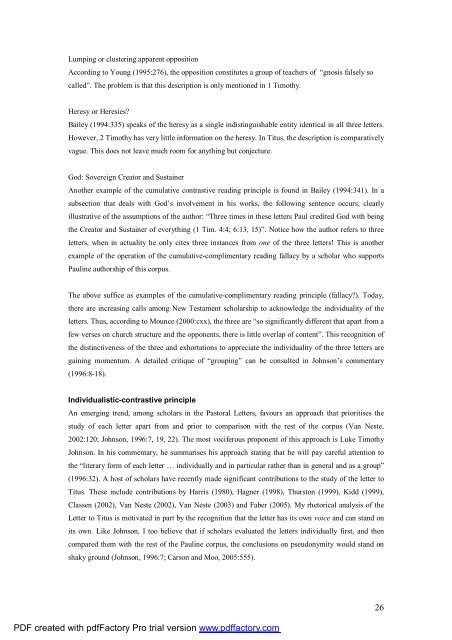A Text centred rhetorical analysis of Paul's Letter to Titus
A Text centred rhetorical analysis of Paul's Letter to Titus
A Text centred rhetorical analysis of Paul's Letter to Titus
Create successful ePaper yourself
Turn your PDF publications into a flip-book with our unique Google optimized e-Paper software.
Lumping or clustering apparent opposition<br />
According <strong>to</strong> Young (1995:276), the opposition constitutes a group <strong>of</strong> teachers <strong>of</strong> “gnosis falsely so<br />
called”. The problem is that this description is only mentioned in 1 Timothy.<br />
Heresy or Heresies?<br />
Bailey (1994:335) speaks <strong>of</strong> the heresy as a single indistinguishable entity identical in all three letters.<br />
However, 2 Timothy has very little information on the heresy. In <strong>Titus</strong>, the description is comparatively<br />
vague. This does not leave much room for anything but conjecture.<br />
God: Sovereign Crea<strong>to</strong>r and Sustainer<br />
Another example <strong>of</strong> the cumulative contrastive reading principle is found in Bailey (1994:341). In a<br />
subsection that deals with God’s involvement in his works, the following sentence occurs, clearly<br />
illustrative <strong>of</strong> the assumptions <strong>of</strong> the author: “Three times in these letters Paul credited God with being<br />
the Crea<strong>to</strong>r and Sustainer <strong>of</strong> everything (1 Tim. 4:4; 6:13, 15)”. Notice how the author refers <strong>to</strong> three<br />
letters, when in actuality he only cites three instances from one <strong>of</strong> the three letters! This is another<br />
example <strong>of</strong> the operation <strong>of</strong> the cumulative-complimentary reading fallacy by a scholar who supports<br />
Pauline authorship <strong>of</strong> this corpus.<br />
The above suffice as examples <strong>of</strong> the cumulative-complimentary reading principle (fallacy?). Today,<br />
there are increasing calls among New Testament scholarship <strong>to</strong> acknowledge the individuality <strong>of</strong> the<br />
letters. Thus, according <strong>to</strong> Mounce (2000:cxx), the three are “so significantly different that apart from a<br />
few verses on church structure and the opponents, there is little overlap <strong>of</strong> content”. This recognition <strong>of</strong><br />
the distinctiveness <strong>of</strong> the three and exhortations <strong>to</strong> appreciate the individuality <strong>of</strong> the three letters are<br />
gaining momentum. A detailed critique <strong>of</strong> “grouping” can be consulted in Johnson’s commentary<br />
(1996:8-18).<br />
Individualistic-contrastive principle<br />
An emerging trend, among scholars in the Pas<strong>to</strong>ral <strong>Letter</strong>s, favours an approach that prioritises the<br />
study <strong>of</strong> each letter apart from and prior <strong>to</strong> comparison with the rest <strong>of</strong> the corpus (Van Neste,<br />
2002:120; Johnson, 1996:7, 19, 22). The most vociferous proponent <strong>of</strong> this approach is Luke Timothy<br />
Johnson. In his commentary, he summarises his approach stating that he will pay careful attention <strong>to</strong><br />
the “literary form <strong>of</strong> each letter … individually and in particular rather than in general and as a group”<br />
(1996:32). A host <strong>of</strong> scholars have recently made significant contributions <strong>to</strong> the study <strong>of</strong> the letter <strong>to</strong><br />
<strong>Titus</strong>. These include contributions by Harris (1980), Hagner (1998), Thurs<strong>to</strong>n (1999), Kidd (1999),<br />
Classen (2002), Van Neste (2002), Van Neste (2003) and Faber (2005). My <strong>rhe<strong>to</strong>rical</strong> <strong>analysis</strong> <strong>of</strong> the<br />
<strong>Letter</strong> <strong>to</strong> <strong>Titus</strong> is motivated in part by the recognition that the letter has its own voice and can stand on<br />
its own. Like Johnson, I <strong>to</strong>o believe that if scholars evaluated the letters individually first, and then<br />
compared them with the rest <strong>of</strong> the Pauline corpus, the conclusions on pseudonymity would stand on<br />
shaky ground (Johnson, 1996:7; Carson and Moo, 2005:555).<br />
PDF created with pdfFac<strong>to</strong>ry Pro trial version www.pdffac<strong>to</strong>ry.com<br />
26

















